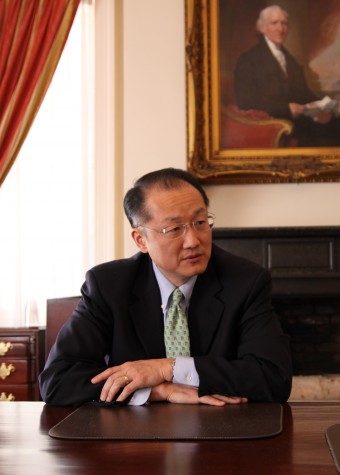
Dartmouth College announced on Monday that Jim Yong Kim would be the school’s 17th president and the first Asian American to head an Ivy League institution.
Kim’s qualifications are beyond perfect.
After graduating from Brown University in 1982 with a major in human biology, he went on to earn a medical degree and a doctorate in anthropology from Harvard University. Kim has headed the World Health Organization’s HIV/AIDS department, been chair of Harvard Medical School’s Department of Global Health and Social Medicine, won a 2003 MacArthur “genius grant”, and was listed as one of the 100 most influential people by Time Magazine in 2006 for his work in saving the world.
As a current Dartmouth student, I applaud the school’s efforts to take a newer, more modern path. Kim’s background in medicine departs heavily from that of presidents past. His appointment has been met with a resounding approval from the community.
It feels comforting to be represented at Dartmouth. While there is a vocal and active Asian American student community, there are only a handful of Asian American professors and administrators. I also think this is a positive step away from a racist comic strip that ran in the campus daily not long ago and the community’s uninspired response. Dartmouth prides itself on its community atmosphere, but there is mild self-segregation that is not uncommon at other schools. While Kim’s appointment will definitely not solve these problems, hopefully in the long run it will serve to mitigate these issues.
Dartmouth is located in the boonies of New Hampshire—two hours north of Boston in a four-block long town called Hanover. All of Dartmouth stereotypes are more or less true. It is the smallest and arguably least well-known Ivy. Kim’s appointment definitely boosts the school’s image up from that of a conservative WASP party school to a progressive and diversity-friendly party institution.
Currently, Asian Americans make up about 5% of the total population in the United States. Of that, about 50% of single-race Asians 25 and older have at least a Bachelor’s degree. It is only 28% for all Americans over 25.
Across the Ivies, the percentages of Asian American students in undergraduate are as follows:
- Brown- 14%
- Columbia – 22%
- Cornell – 18%
- Dartmouth – 12%
- Harvard – 16%
- University of Pennsylvania (”PENN”) – 23.3%
- Princeton – 15%
- Yale – 14%
Our “model minority” stigma has been a blessing and a curse. There has been evidence of discrimination in the college admissions process. It’s a touchy subject.
In 2006, the Wall Street Journal published an article that exposed a bias against Asian Americans in college admissions.
“Asian American students have higher average SAT scores than any other government-monitored ethnic group, and selective colleges routinely reject them in favor of African American, Hispanic and even white applicants with lower scores in order to have more diverse campuses and make up for past discrimination.”
When the University of California system eliminated affirmative action in 1996, Asian American enrollment boomed, at the expense of African and Hispanic Americans populations, whose percentages saw a decline. Admissions preferences in elite institutions was also the subject of a Princeton University study which concluded that there would be a dramatic increase of Asian Americans in elite universities if race were no longer considered in college admissions.
And of course, how can we forget the guy who sued Princeton?
The appointment of an Asian American to such a lofty position is a major step for American academia. Kim, however, is not the first Asian American to be the head of a major American university. That honor belongs to Chang-lin Tien, eighth Chancellor of UC Berkeley. And last year, Rhode Island School of Design chose John Maeda as its newest leader.
Anyhow, this has been great publicity for the school. Maybe it will lead to fewer people confusing us with Darth Vader’s mouth.
Thanks to John, whose links I stole.








